
2 years of COVID-19 in B.C.: Here's how the province's response has changed
Two years have now passed since the first COVID-19 case was publicly announced in B.C., and the second year of the pandemic saw wide distribution of vaccines and multiple new variants of the disease.
Jan. 28, 2020, marked the first time a case of the novel coronavirus was formally announced in B.C. after a man who travelled to the province from Wuhan, China, tested positive.
Since then, more than more than 318,000 people have also confirmed they've had the disease through PCR testing and epidemiological links. That number is an underrepresentation, however, as many cases went untested, particularly since B.C. changed its PCR testing strategy.
For the second year in a row, British Columbians experienced varying degrees of public health orders, including the introduction of the B.C. Vaccine Card program, which limited access to some non-essential businesses and activities. Just this week, that program was extended through June.
"Remembering where we have been and what we have come through can help us put where we are today in a perspective and can help us remember a lot of what we have learned and experienced together," Dr. Bonnie Henry said Friday.
"Each of these waves has had their unique challenges and our response has adapted to that. We have made extraordinary societal efforts and these efforts have saved countless lives."
VACCINE ROLLOUT EXPANDS
While B.C.'s very first COVID-19 vaccine was given on Dec. 15, 2020, the province's full immunization rollout was announced in late January. Under the initial plan, everyone aged 18 and older was expected to get their first dose by September.
But in the spring, increased vaccine shipments allowed the province to move up that timeline, meaning most eligible adults were able to get their first shot by May. Later that same month, the province extended vaccine registration to everyone aged 12 and older.
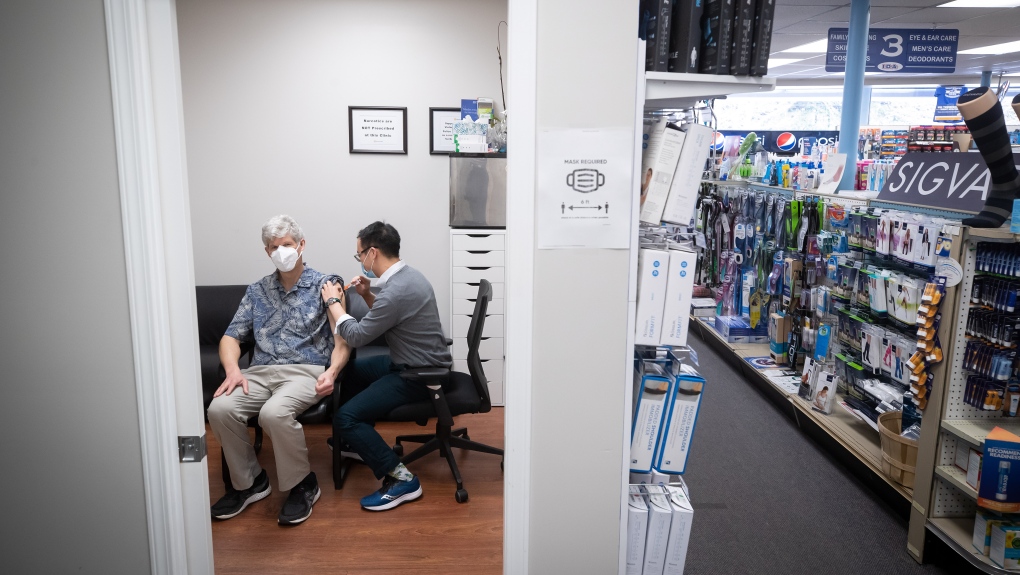 Pharmacist Mario Linaksita, right, administers the Oxford-AstraZeneca COVID-19 vaccine to Jonathan Vogt, 62, at University Pharmacy, in Vancouver, on Thursday, April 1, 2021. THE CANADIAN PRESS/Darryl Dyck
Pharmacist Mario Linaksita, right, administers the Oxford-AstraZeneca COVID-19 vaccine to Jonathan Vogt, 62, at University Pharmacy, in Vancouver, on Thursday, April 1, 2021. THE CANADIAN PRESS/Darryl Dyck
In August, health officials announced a change in the interval between first and second doses, reducing it from 49 days to 28. The shorter span between doses came as some parts of the province saw increasing numbers of community outbreaks, particularly in the Central Okanagan.
In September, the province began rolling out booster doses to seniors and other clinically extremely vulnerable people.
At first, Henry said officials were unsure if everyone in the population would be encouraged to get a booster, particularly those who are young and healthy. But the following month, Henry and Health Minister Adrian Dix said new data suggested a booster could give longer-lasting protection.
Another major milestone in B.C.'s immunization rollout was when Health Canada approved Pfizer's vaccine for children aged five to 11. The vaccine was approved on Nov. 19 and some invitations to book doses in B.C. were sent out later that month.
 Dr. Bonnie Henry welcomed kids and their parents to some of the first pediatric COVID-19 vaccine appointments, November 29, 2021.
Dr. Bonnie Henry welcomed kids and their parents to some of the first pediatric COVID-19 vaccine appointments, November 29, 2021.
By the end of the year, the rollout of booster doses was accelerated due to the rapid spread of the Omicron variant. People wanting their third shot were contacted to book their appointment six months after getting their second dose.
As of Jan. 27, nearly 90 per cent of eligible British Columbians aged five and older have had at least one COVID-19 vaccine dose. Nearly 84 per cent have had two doses. About 43 per cent of those aged 12 and older have gotten a booster.
CHANGING RESTRICTIONS
In spite of vaccinations changing the pandemic in many ways, British Columbians still faced shifting restrictions and health orders as officials tried to manage transmission of the disease.
"A pandemic response requires extraordinary efforts to control it because of the potential impacts," Henry said Friday.
"At the very beginning we took a lot of measures. Public health measures, government measures, we stood together by staying apart."
The year began with strict COVID-19 measures still in place, including limits to all personal gatherings that were first announced in November 2020. It wasn't until mid-March that outdoor gatherings of up to 10 people were permitted. At the time, Henry reiterated that indoor gatherings and crowded situations were the riskiest places for transmission.
About a month later, Henry declared the province was in its third wave of the pandemic. Case counts and hospitalizations soared to record-breaking highs and, that same month, cases of the troubling Delta variant were confirmed in the province. By late April, travel restrictions were in place, prohibiting people from moving between large health areas for non-essential reasons.
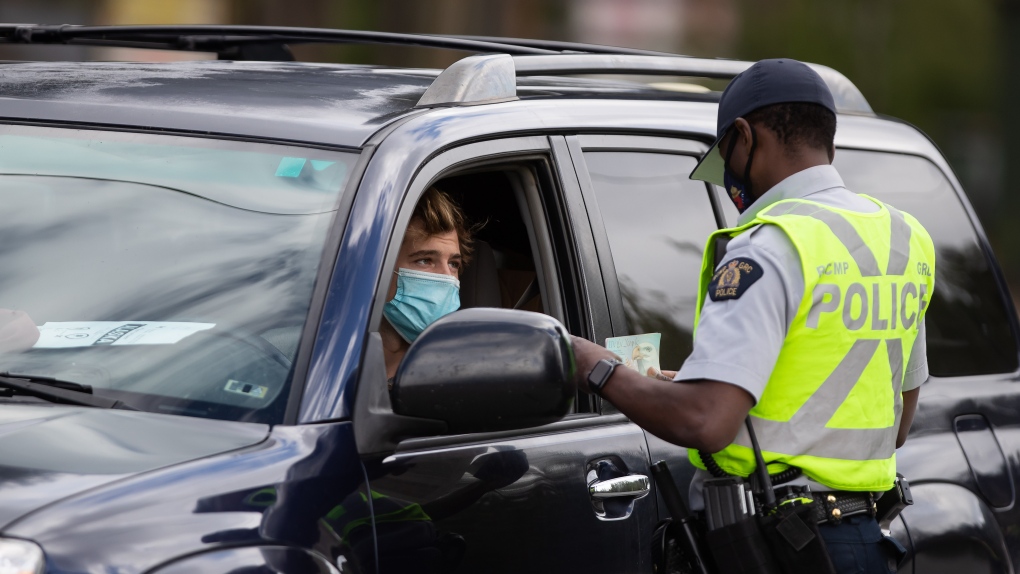 An RCMP officer checks the passport of a U.S. citizen traveling to Alaska, at a COVID-19 travel checkpoint on the Trans-Canada Highway north of Boston Bar, B.C., on Friday, May 7, 2021. THE CANADIAN PRESS/Darryl Dyck
An RCMP officer checks the passport of a U.S. citizen traveling to Alaska, at a COVID-19 travel checkpoint on the Trans-Canada Highway north of Boston Bar, B.C., on Friday, May 7, 2021. THE CANADIAN PRESS/Darryl Dyck
It took one more month – until May 25 – for health officials to finally announce the province's restart plan. That initial phase included allowing small, personal indoor gatherings, but many other rules were still in place.
By mid-June, the province lifted more restrictions, including the ban on travel within the province. Just two weeks later, with 80 per cent of eligible adults having at least one COVID-19 vaccine dose, the province moved to Step 3 of its restart plan, which allowed British Columbians the opportunity to "return to usual" on personal gatherings, have no limits to indoor dining, go to casinos for the first time since the start of the pandemic and no longer wear masks in indoor public spaces.
But the province never got to Step 4, the final stage of its restart plan.
At first, officials hoped they'd be able to enter Step 4 in early September. Instead, the more transmissible Delta variant sent counts rising once again in some parts of the province, prompting regional health orders first in the Central Okanagan, followed by all of Interior Health. Restrictions were later introduced in Northern Health too.
On Aug. 23, the B.C. Vaccine Card was announced and, the following day, the mask mandate for indoor public spaces was brought back. The vaccine card was officially implemented in mid-September, requiring proof of COVID-19 immunization to access some non-essential businesses like restaurants and event venues.
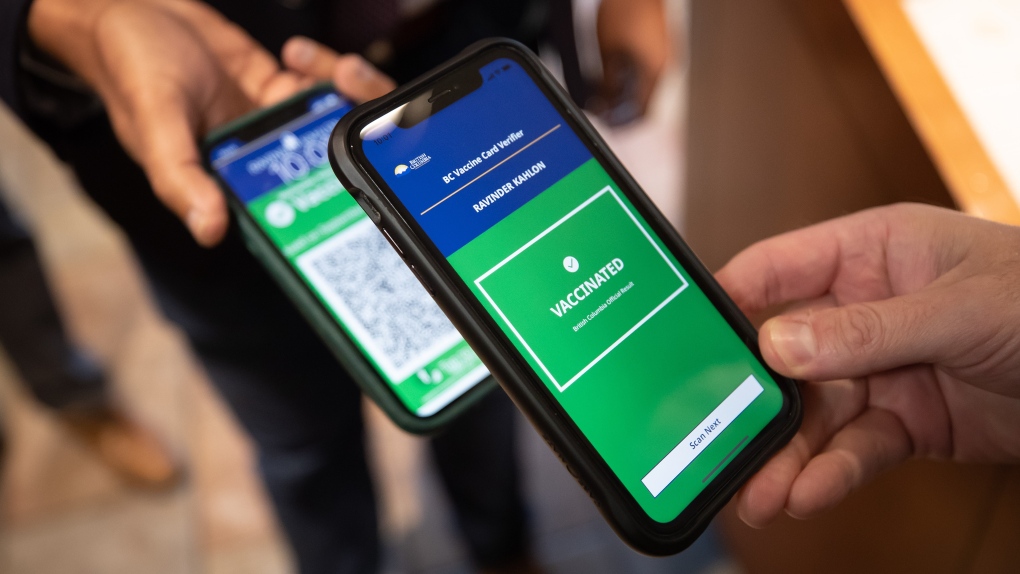 B.C. Minister of Jobs, Economic Recovery and Innovation Ravi Kahlon has his provincial COVID-19 vaccine card scanned by White Spot restaurant general manager Bill Warwick, before having breakfast in Delta, B.C., on Wednesday, Sept. 15, 2021. (Darryl Dyck / THE CANADIAN PRESS)
B.C. Minister of Jobs, Economic Recovery and Innovation Ravi Kahlon has his provincial COVID-19 vaccine card scanned by White Spot restaurant general manager Bill Warwick, before having breakfast in Delta, B.C., on Wednesday, Sept. 15, 2021. (Darryl Dyck / THE CANADIAN PRESS)
By late November, the highly transmissible Omicron variant arrived in B.C. and just before the Christmas holidays, Henry announced a string of new health measures as the province braced for an explosion in cases. Once again, personal gatherings were limited and there were stricter rules for dining at restaurants. All organized New Year's Eve events were cancelled. Just three days later, gyms, bars and night clubs were all closed and event venues had their capacity cut in half.
While most of those health measures were extended in the new year through mid-February, gyms were permitted to reopen on Jan. 18 with new guidelines.
The B.C. Vaccine Card, originally set to expire on Jan. 31, was extended through the end of June.
SHIFT IN DATA, TESTING, RESPONSE
The second year of B.C.'s pandemic response also saw dramatic changes in how data was collected, who was tested and how the province responded to case counts. In early 2021, British Columbians were hoping increased vaccination rates would lead to fewer restrictions. But multiple variants impeded those plans, and in some cases, forced health officials to adjust their strategies.
In March, just before B.C. entered its third wave, officials were criticized for their response to rising case counts, with some health-care workers warning their intensive care units were full of coronavirus patients. For weeks, B.C. delayed implementing further measures, and instead appeared to focus on the rollout of vaccines. In April, the province saw record-high case counts and hospitalizations rates.
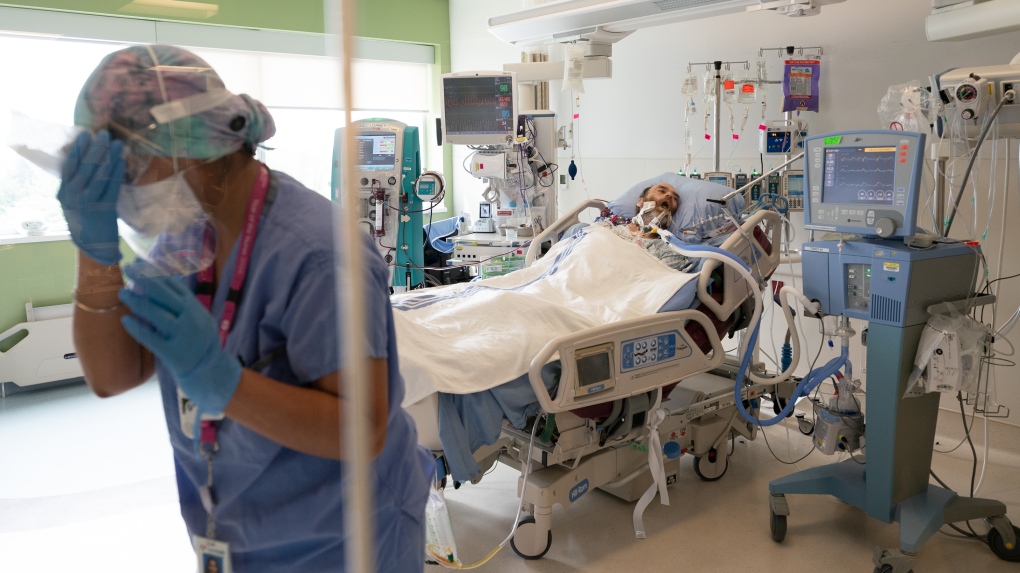 Registered Nurse Manjot Kaur Munday, disinfects her visor while in the room of COVID-19 patient Joseph Trudeau, 49, of Surrey, B.C. at the COVID-19 Intensive Care Unit at Surrey Memorial Hospital in Surrey, B.C., Friday, June 4, 2021. THE CANADIAN PRESS/Jonathan Hayward
Registered Nurse Manjot Kaur Munday, disinfects her visor while in the room of COVID-19 patient Joseph Trudeau, 49, of Surrey, B.C. at the COVID-19 Intensive Care Unit at Surrey Memorial Hospital in Surrey, B.C., Friday, June 4, 2021. THE CANADIAN PRESS/Jonathan Hayward
Experts also pushed for health officials to release more information on how they made their pandemic policy. One Metro Vancouver data analyst said some health workers had little sense of what was happening at the start of the third wave because they only had access to the same information as the public.
And to some, even that limited information seemed outdated. Henry and Dix were questioned in late April about why health authorities were solely focusing on droplet transmission of the virus, and not airborne. Details were eventually quietly added to health authority websites to add information about aerosols.
Once Omicron arrived in B.C., the province's testing capacity was quickly strained, leading to significant changes in how data was collected. In mid-December, those seeking COVID-19 tests reported hours-long waits at some centres as case counts surged. Those waits continued for days and eventually, some sites began giving out rapid tests or sending people home from the lineups.
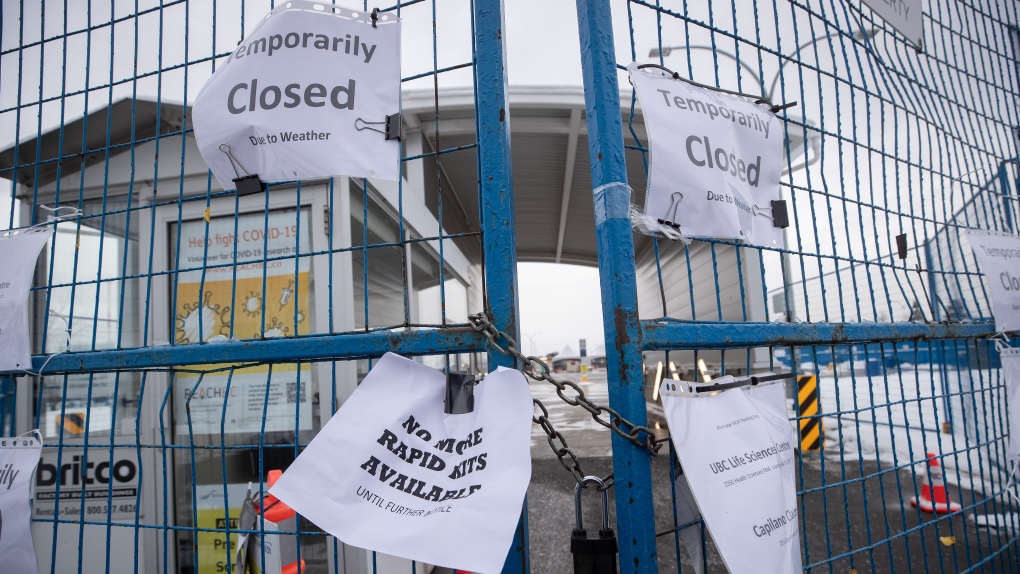 A locked gate and notices are seen posted at a COVID-19 testing centre that has been temporarily closed due to cold weather, in Richmond, B.C., on Sunday, December 26, 2021. THE CANADIAN PRESS/Darryl Dyck
A locked gate and notices are seen posted at a COVID-19 testing centre that has been temporarily closed due to cold weather, in Richmond, B.C., on Sunday, December 26, 2021. THE CANADIAN PRESS/Darryl Dyck
"The intensity and the spread of Omicron meant that we needed to change our approach to testing," Henry said.
"It was not possible to continue with trying to test everybody. Our capacity was overreached, so that meant we had to go back to making sure that we had those accurate PCR tests available for those people who needed them most."
Pressure also grew for the province to accelerate its booster rollout, though that didn't happen until the end of December.
By the end of the year, officials announced a change in its testing strategy, saying those who are vaccinated and not high risk should simply self-isolate, rather than confirming they have COVID-19. While this called into question the accuracy of daily case counts, Henry said those figures had never fully reflected transmission in the province.
Officials also shifted how hospitalizations were counted in the new year. In mid-January, the province moved to "census hospitalization reporting," meaning people who test positive during routine screenings at hospitals would also be counted. As a result, hospitalization figures appeared to skyrocket.
About a week before B.C. marked two years since announcing its first COVID-19 case, another major shift in the province's response was noted. In a COVID-19 briefing last week, it appeared officials moved towards treating COVID-19 more like the flu or a common cold, with Henry saying the response was changing because of the new variant and because of vaccination rates across B.C.
"There have been five waves, many variants and likely many more to come," Henry said Friday.
"We've been on an incredibly arduous and long journey and, no, I didn't think we would be on this phase of the journey for this long.
"But it is the reality that we have to accept and so much has happened in those last two years, but we have the tools and the resources and the wherewithal to help us deal with whatever is going to lie ahead."
CTVNews.ca Top Stories

BREAKING King Charles' cancer treatment progressing well, says Buckingham Palace
King Charles III’s doctors are 'sufficiently pleased' with his cancer treatment and he is expected to return to public-facing duties, Buckingham Palace announced on Friday.
BREAKING Orca calf that was trapped in B.C. lagoon for weeks swims free
An orca whale calf that has been stranded in a B.C. lagoon for weeks after her pregnant mother died swam out on her own early Friday morning.
'Unacceptable': Trudeau reacts after AFN chief says headdress taken from plane cabin
After the Assembly of First Nations' national chief said her headdress was taken from an airplane cabin this week, Prime Minister Justin Trudeau called the incident 'unacceptable' and a 'mistake' on the part of Air Canada.
Sophie Gregoire Trudeau on navigating post-political life, co-parenting and freedom
Sophie Gregoire Trudeau says there is 'still so much love' between her and Prime Minister Justin Trudeau, as they navigate their post-separation relationship co-parenting their three children.
From faulty kids' cribs to flammable kids' bathrobes, here are the recalls of the week
Health Canada issued recalls for various items this week, including kids’ bathrobes, cribs and henna cones.
Taylor Swift dons Montreal designer's dress in 'Fortnight' video
A pair of Montreal designers' work has now been viewed over 41 million times. Taylor Swift dons a Victorian throwback black gown in her latest music video, 'Fortnight', designed by UNTTLD due Simon Belanger and Jose Manuel Saint-Jacques.
'Too young to have breast cancer': Rates among young Canadian women rising
Breast cancer rates are rising in Canada among women in their 20s, 30s and 40s, according to research by the University of Ottawa (uOttawa).
'Violation': CSIS had officer investigated after she reported a superior raped her
A CSIS officer's allegations that she was raped repeatedly by a superior in agency vehicles set off a harassment inquiry, but also triggered an investigation into her that concluded the alleged attacks were a “misuse” of agency vehicles by the woman.
'I was scared': Ontario man's car repossessed after missing two repair loan payments
An Ontario man who took out a loan to pay for auto repairs said his car was repossessed after he missed two payments.































